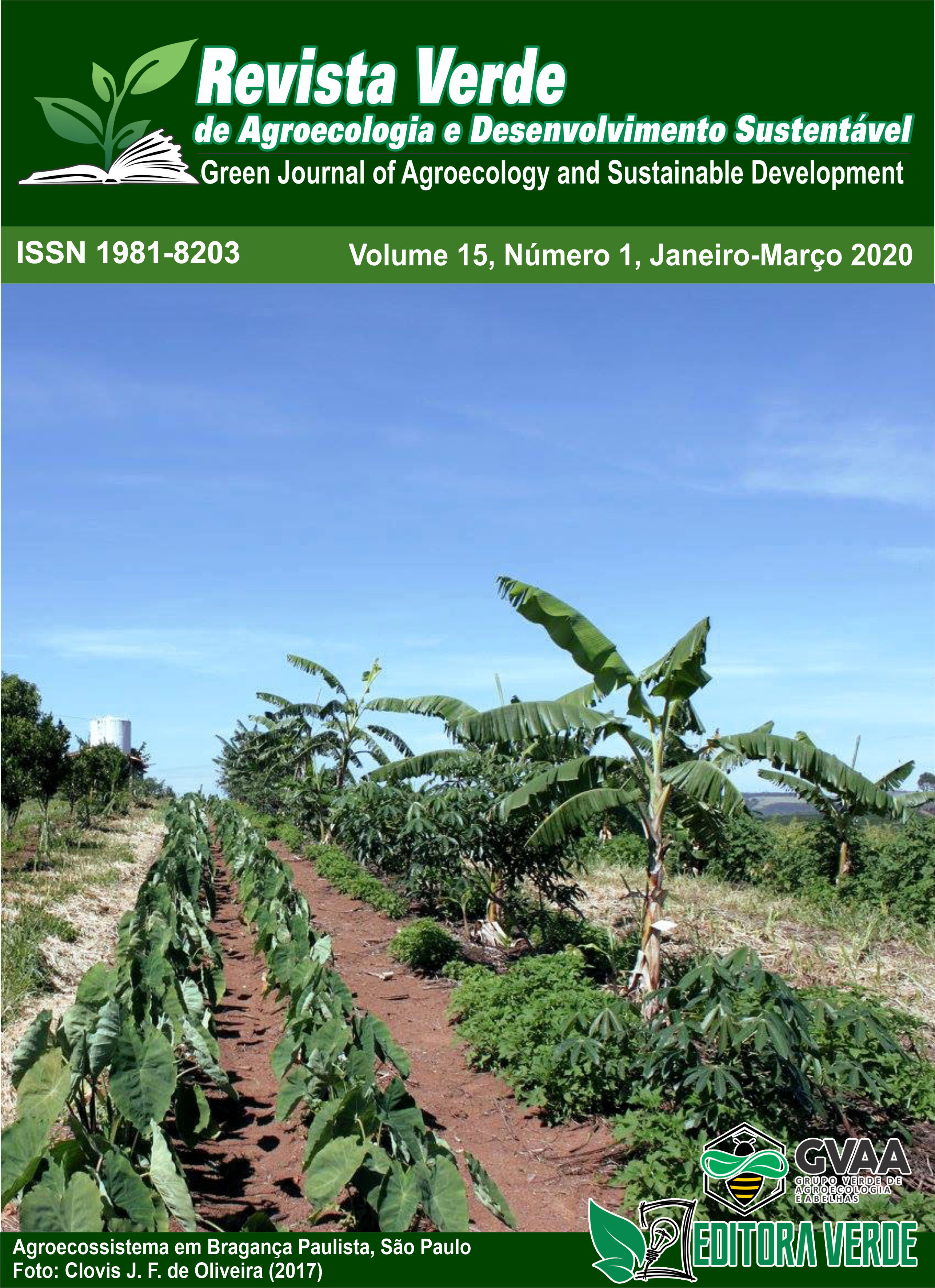Productive systems Sustainable in the Serraria County, Paraiba, Brazil
DOI:
https://doi.org/10.18378/rvads.v15i1.6881Keywords:
Family farming, Agroecology, Agroforestry SystemsAbstract
The adoption of agroecological practices such as consortium and agroforestry systems are effective in improving and maintaining soil quality, with the delimitation of factors that may be related to the preservation of soil fertility being essential. The indicators of sustainability of participative soils are characterized by their ease of application, which can be used by farmers themselves and contributing to improvements in family farming production systems. The objective was to quantify the levels of resilience and diversity in the different agroecosystems located in the Serraria, PB County. The studied agroecosystems had three contortium, three monocultures and three areas in transition to an agroforestry system. For the study, the Participative Rural Diagnosis was used as a tool combined with the method of attributing scores applied to social, economic and sustainable indicators. In not all systems, soluble chemical fertilizers and pesticides are used in their management, being the model of family production. From the analysis, it can be concluded that in small monoculture areas it is possible to guarantee a certain level of resilience of the agroecosystem when worked in a manner in keeping with the principles of management and conservation.Downloads
References
BRASIL. Instituto Brasileiro de Geografia e Estatística (Org.). Infográficos: dados gerais do município. 2018. Disponível em: <https://cidades.ibge.gov.br/brasil/pb/serraria/panorama>. Acesso em 23 de agosto de 2018.
COSTA, M. B. B. Reflexões sobre o Ensino Superior em Agroecologia. Cadernos de Agroecologia -– Vol. 11, No. 1, 2016.
LIMA, J. F. de. Feira da Agricultura Familiar de Serraria-PB e as Tecnologias Agroecológicas para o Fortalecimento e Valorização dos Agricultores Familiares. 2019. 102 f. Dissertação (Mestrado) - Curso de Pós-graduação em Ciências Agrárias (agroecologia), Universidade Federal da Paraíba, João Pessoa, 2019.
LIMA, G. L.; AZEVEDO, P. H.; BARROS, F.F. C.; BÍLIO, R. S.; GARCIA, S. S. Implicações socioambientais dos sistemas agroflorestais em unidades produtivas na região do Vale do Guaporé mato-grossense. Revista Acadêmica: Ciências Agrárias Ambientais. Curitiba, v. 11, Supl. 2, p. S137-S149, 2013. 10.7213/academica.10.S02.AO16
MELO, L. F.; ARAÚJO, A. E. Agroecologia e nutrição no combate a produção e consumo de agrotóxicos e na promoção de hábitos alimentares mais saudáveis. Revista Lugares de Educação. Bananeiras, v. 6, n. 12, p.125-138, 2016.
MOREIRA, R. M.; CARMO, M. S. do. Agroecologia na construção do desenvolvimento rural sustentável. Agric. São Paulo, v. 51, n. 2, p. 37-56, 2004.
MICROSOFT OFFICE. Suíte de Aplicativos. Microsoft, Redmond, WA, EUA. 2010.
NOCE, M. A.; FERREIRA NETO, J. A. Uma análise de política pública brasileira de desenvolvimento rural, com foco no combate à pobreza no campo. Cadernos de Ciências Sociais da UFRPE, vol. I, n. 8, 2016.
NICHOLLS, C. I.; ALTIERI, M. A.; DEZANET, A.; LANA, M. A Rapid, Farmer-Friendly Agroecological Method to Estimate Soil Quality and Crop Health in Vineyard Systems. Science and Ecology. Biodynamics. Autumn, 2004.
OLIVEIRA, M. A. C. de; SAMBUICHI, R. H. R; SILVA, A. P. M. da. Experiências agroecológicas brasileiras: uma análise à luz do desenvolvimento Local. Rev. Bras. de Agroecologia, 2013.
PAREYN, F.; GOMES, D.; FERREIRA, J. P.; SEBASTIÃO, E.; SILVA, J. da. Diagnóstico Rural Participativo: PA Catolé – Serra Talhada/PE. Recife, 2006. Disponível em: <http://www.plantasdonordeste.org/assentamento/Produto_1/DRP_Catole.pdf>. Acesso em 06 junho de 2018.
REFATI, D. C; FABRINI, J. E; MARSCHNER, W. R. O trabalho das mulheres nos assentamentos Antônio Companheiro Tavares em São Miguel do Iguaçu e Ander Rodolfo Henrique em Diamante do Oeste – Paraná. Revista NERA, Presidente Prudente, Ano 20, nº. 35, pp. 83-107, Jan-Abr., 2017.
REYNOLDS, W. D,; DRURY, C. F.; ZHANG, T. Land management effects on the near-surface physical quality of a clay loam soil. Soil and Tillage Research, v. 96, p. 316–330, 2007. 10.1016/j.still.2007.07.003
REYNOLDS, W.D.; DRURY, C. F.; TAN, C. S.; FOX, C. A. Use of indicator sand pore volume-function characteristics to quantify soil physical quality. Geoderma, v. 152, n. 3-4, p. 252-263, 2009. 10.1016/j.geoderma.2009.06.009
SIMÕES, V. J. L. P.; LEITE, M. L. V.; SOUZA, E. S.; LUCENA, L. R. R.; IZIDRO, J. L. P.S. Indicadores de sustentabilidade com base na qualidade do solo e acúmulo de fitomassa em pastagens degradadas. Agrarian Academy, Centro Cientifico Conhecer, v.5, n.9; p. 253, 2018. 10.18677/Agrarian_Academy_2018a26
VALANI, G. P.; OLIOSI, G.; GONTIJO, I.; PARTELLI, F. L. Atributos físicos do solo em áreas de seringueira e pastagem em monocultivo contrastado ao sistema silvipastoril. Revista Univap. v. 22, n. 40, Edição Especial 2016. 10.18066/revistaunivap.v22i40.833
VIEIRA, M. V. M.; GIUNTI O. D.; GRIS, C.; SILVA, F., A. V. Indicadores de sustentabilidade e influência de sistemas agroflorestal e convencional sobre a qualidade do solo e do café arábica em Piumhi-MG. Revista Verde, v. 10, n.2, p. 229 - 238, 2015. 10.18378/rvads.v10i2.3329















